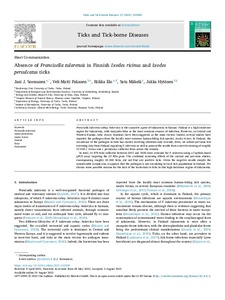Absence of Francisella tularensis in Finnish Ixodes ricinus and Ixodes persulcatus ticks
Sormunen Jani J; Pakanen Veli-Matti; Elo Riikka; Mäkelä Satu; Hytönen Jukka
Absence of Francisella tularensis in Finnish Ixodes ricinus and Ixodes persulcatus ticks
Sormunen Jani J
Pakanen Veli-Matti
Elo Riikka
Mäkelä Satu
Hytönen Jukka
Julkaisun pysyvä osoite on:
https://urn.fi/URN:NBN:fi-fe2021093049016
https://urn.fi/URN:NBN:fi-fe2021093049016
Tiivistelmä
Francisella tularensis subsp. holarctica is the causative agent of tularaemia in Europe. Finland is a high-incidence region for tularaemia, with mosquito bites as the most common sources of infection. However, in Central and Western Europe, ticks (Acari: Ixodidae) have been suggested as the main vectors. Indeed, several studies have reported the pathogen from the locally most common human-biting tick species, Ixodes ricinus. In Finland, the occurrence of the pathogen in ticks has started receiving attention only recently. Here, we collate previous tick screening data from Finland regarding F. tularensis as well as present the results from a novel screening of roughly 15 000 I. ricinus and I. persulcatus collected from across the country. In total, 14 878 ticks collected between 2015 and 2020 were screened for F. tularensis using a TaqMan-based qPCR assay targeting the 23 KDa gene. The combined screening efforts of the current and previous studies, encompassing roughly 20 000 ticks, did not find any positive ticks. Given the negative results despite the considerable sample size, it appears that the pathogen is not circulating in local tick populations in Finland. We discuss some possible reasons for the lack of the bacterium in ticks in this high-incidence region of tularaemia.
Kokoelmat
- Rinnakkaistallenteet [27094]
